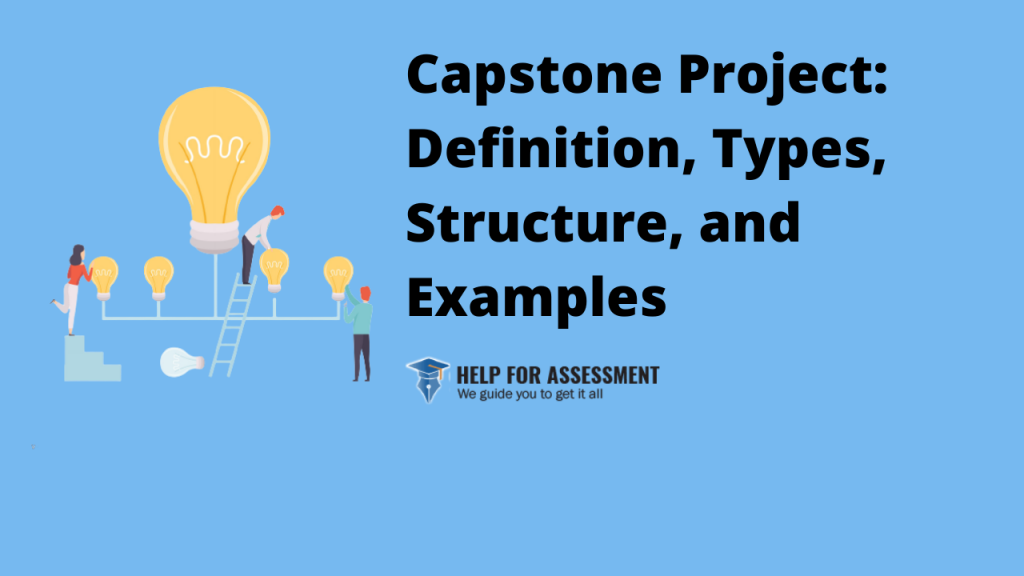
Buy ready-to-submit essays. No Plagiarism Guarantee
Note: All our papers are written by real people, not generated by AI.
Capstone projects are research-based academic assignments that require students to integrate their knowledge and skills learned during their academic tenure to solve real-world problems or present an innovative solution to a specific problem. Capstone projects are a mandatory requirement in most undergraduate and graduate programs, and the level of complexity varies depending on the discipline and degree level. This article will provide a comprehensive overview of capstone projects, including their definition, types, structure, and examples.
Definition of Capstone Projects
A capstone project is a culminating academic assignment that requires students to synthesize and apply their knowledge, skills, and competencies learned throughout their academic program to a real-world problem or issue. The objective of the capstone project is to provide students with an opportunity to showcase their learning outcomes and demonstrate their ability to apply theoretical knowledge and practical skills to a specific problem. Capstone projects may take different forms, including research papers, case studies, presentations, and prototypes, among others.
Capstone projects are usually interdisciplinary, meaning that they require students to combine knowledge from different fields to create a comprehensive solution to a specific problem. The capstone project may involve collaboration with other students, faculty members, and industry experts. The project is typically conducted during the final semester of the academic program, and it may take several months to complete, depending on the scope and complexity of the project.
Need Help Writing an Essay?
Tell us about your ASSIGNMENT and we will find the best WRITER for your paper.
Get Help Now!Types of Capstone Projects
Capstone projects can be classified into several types, depending on the academic program and the scope of the project. Here are some common types of capstone projects:
Research-Based Capstone Projects
Research-based capstone projects involve conducting original research on a specific problem or issue. Students are required to identify a research problem, conduct a literature review, collect and analyze data, and present their findings in a research paper or presentation. Research-based capstone projects are common in social sciences, natural sciences, and engineering.
Case Study-Based Capstone Projects
Case study-based capstone projects involve analyzing a real-life situation or problem and presenting a comprehensive analysis of the issue. Students are required to identify a case study, conduct research, analyze the case study, and present their findings in a written report or presentation. Case study-based capstone projects are common in business, management, and healthcare.
Creative Project-Based Capstone Projects
Creative project-based capstone projects involve creating a product or service that addresses a specific problem or issue. Students are required to identify a problem, develop a concept, design a prototype, and present their product or service in a written report or presentation. Creative project-based capstone projects are common in design, art, and engineering.
Service-Learning Capstone Projects
Service-learning capstone projects involve working with a community organization or non-profit group to address a specific problem or issue. Students are required to identify a community need, work with the community organization, and develop a solution to the problem. Service-learning capstone projects are common in social work, education, and public health.
Structure of Capstone Projects
The structure of a capstone project may vary depending on the academic program and the type of project. However, most capstone projects follow a similar structure, which includes the following sections:
Introduction
The introduction section provides an overview of the problem or issue that the capstone project aims to address. The introduction should clearly state the research question, the significance of the problem, and the objectives of the project.
Literature Review
The literature review section provides a critical analysis of the existing research on the problem or issue. The literature review should identify the knowledge gap in the field and provide a rationale for the research question.
Methodology
The methodology section describes the research design, data collection methods, and data analysis techniques. The methodology should be clear, concise, and relevant to the research question.
Results
The results section presents the findings of the research or analysis. The results should be presented in a logical and clear manner, with appropriate graphs, tables, and charts.
Discussion
The discussion section provides a critical analysis of the findings and relates them to the research question. The discussion should also include the limitations of the study and recommendations for future research.
Conclusion
The conclusion section summarizes the main findings of the study and provides a conclusion to the research question. The conclusion should also include the significance of the study and its contribution to the field.
References
The reference section includes a list of all the sources cited in the capstone project. The references should be formatted according to the appropriate citation style.
Examples of Capstone Projects
Here are some examples of capstone projects to give you an idea of what a capstone project may look like:
Research-Based Capstone Project Example
Title: The Effect of Social Media on Mental Health in Adolescents
Objective: To investigate the relationship between social media usage and mental health in adolescents.
Methodology: A cross-sectional survey design was used to collect data from 200 adolescents between the ages of 14-18. The data were analyzed using descriptive and inferential statistics.
Results: The study found that social media usage was significantly associated with depression, anxiety, and stress in adolescents.
Discussion: The study provides evidence for the need to regulate social media usage in adolescents and to provide mental health support for those who experience negative mental health outcomes.
Case Study-Based Capstone Project Example
Title: A Case Study of Airbnb in the Hospitality Industry
Objective: To analyze the impact of Airbnb on the hospitality industry and identify strategies for hotels to compete with Airbnb.
Methodology: A qualitative case study approach was used to analyze the business model of Airbnb and its impact on the hospitality industry. Data were collected through interviews with hotel managers and Airbnb hosts.
Results: The study found that Airbnb has disrupted the traditional hotel industry by providing a more personalized and affordable alternative. Hotels can compete with Airbnb by providing unique experiences, personalization, and value-added services.
Discussion: The study provides insights into the challenges and opportunities of the hospitality industry in the era of sharing economy platforms like Airbnb.
Creative Project-Based Capstone Project Example
Title: Design and Development of a Mobile App for Emergency Medical Services
Objective: To design and develop a mobile app that provides emergency medical services to the public.
Methodology: A design thinking approach was used to develop the mobile app. The design process included user research, ideation, prototyping, and user testing.
Results: The mobile app provides real-time emergency medical services to the public, including ambulance dispatch, first aid instructions, and emergency contact information.
Discussion: The mobile app provides a solution to the problem of accessing emergency medical services in a timely and efficient manner.
Service-Learning Capstone Project Example
Title: Addressing Food Insecurity in a Local Community
Objective: To work with a local food bank to address food insecurity in the community.
Methodology: The project involved working with a local food bank to identify the needs of the community and develop strategies to address food insecurity. The project included fundraising, volunteer recruitment, and community outreach.
Results: The project raised $10,000 for the food bank and provided food and resources to over 100 families in the community.
Discussion: The project provides an example of how community-based organizations can work together to address social issues and improve the lives of community members.
Conclusion
In conclusion, capstone projects are an essential component of undergraduate and graduate academic programs. Capstone projects provide students with an opportunity to apply their theoretical knowledge and practical skills to real-world problems or issues. Capstone projects may take different forms, including research papers, case studies, presentations, and prototypes,
depending on the discipline and program requirements. However, all capstone projects follow a general structure that includes an introduction, literature review, methodology, results, discussion, conclusion, and references.
Examples of capstone projects show the diversity of topics and formats that are possible. They can range from research-based projects that investigate a particular phenomenon or issue, to creative projects that involve developing a product or service, to service-learning projects that involve community engagement and social impact. Regardless of the type of project, capstone projects require careful planning, execution, and analysis to achieve the desired outcomes.
One of the benefits of capstone projects is that they provide students with an opportunity to demonstrate their skills and knowledge to potential employers or graduate schools. Capstone projects can also serve as a portfolio of work that students can showcase to demonstrate their abilities in a particular field.
Capstone projects also provide opportunities for interdisciplinary collaboration and cross-disciplinary learning. Many capstone projects involve working with professionals or experts from other fields to tackle complex issues that require diverse perspectives and skills. This can lead to innovative solutions and a deeper understanding of the interconnectedness of different fields.
In conclusion, capstone projects are a valuable and rewarding experience for undergraduate and graduate students. They provide an opportunity to apply theoretical knowledge and practical skills to real-world problems or issues, and demonstrate competency in a particular field of study. Capstone projects come in different forms and cover a wide range of topics and disciplines. However, all capstone projects follow a general structure that includes an introduction, literature review, methodology, results, discussion, conclusion, and references.
Get Fast Writing Help – No Plagiarism Guarantee!
Need assistance with your writing? Look no further! Our team of skilled writers is prepared to provide you with prompt writing help. Rest assured, your work will be entirely original and free from any plagiarism, as we offer a guarantee against it. Experience swift and dependable writing assistance by reaching out to us today!
Top-Rated Essay Writing Service | GET Flawless papers for All Your classes!



